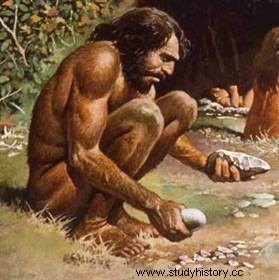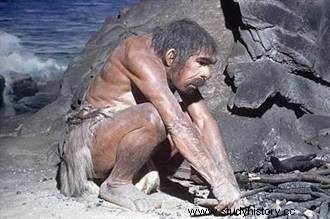 The invention or rather the mastery of fire was done very gradually, and over a very long period of time. For a long time it was thought that fire appeared at the time of Homo erectus 500,000 years ago and that its use had developed under Homo sapiens. Recent research in Africa has revealed traces of a much older use of fire. The circumstances of the discovery of the fire remain difficult to determine:is it recovered from a natural fire and then maintained, or is it the result of the friction of materials? The question remains unanswered...
The invention or rather the mastery of fire was done very gradually, and over a very long period of time. For a long time it was thought that fire appeared at the time of Homo erectus 500,000 years ago and that its use had developed under Homo sapiens. Recent research in Africa has revealed traces of a much older use of fire. The circumstances of the discovery of the fire remain difficult to determine:is it recovered from a natural fire and then maintained, or is it the result of the friction of materials? The question remains unanswered...
The oldest archaeological traces of hearths
Dating the discovery of the domestication of fire by man is not easy. The oldest archaeological remains, located in Africa, are over a million years old, and consist of burnt bones and sediment heated with naturally occurring fire. The 800,000-year-old site of Gesher Benot Ya'aqov in Israel appears to be the earliest evidence of the domestication of fire. Traces of hearths made of burnt wood and carved flint have been found there, as well as reliefs of meals that suggest the presence of fires lit and controlled by man.
 The fireplaces, which prove the real domestication of fire by man, date back approximately 400,000 years. In Europe, several hearths are built in small pits or on pebble slabs, sometimes protected from the winds by low walls. At that time, it was still difficult to determine how men got hold of fire. Perhaps due to the friction of two pieces of wood. The original “lighter” is around 35,000 years old. They were nodules of iron sulphide which, when struck on a hard rock, produced sparks to light a fireplace.
The fireplaces, which prove the real domestication of fire by man, date back approximately 400,000 years. In Europe, several hearths are built in small pits or on pebble slabs, sometimes protected from the winds by low walls. At that time, it was still difficult to determine how men got hold of fire. Perhaps due to the friction of two pieces of wood. The original “lighter” is around 35,000 years old. They were nodules of iron sulphide which, when struck on a hard rock, produced sparks to light a fireplace.
Fire at the origin of modern man
With the invention of the tool, the mastery of fire probably played an essential role in the evolution of humanity, favoring the emergence of modern man . This new source of energy, as a mode of artificial lighting, freed man from the natural constraints of the rhythm of the sun and temperature variations. He can now move around at night and conquer colder areas. Used as a method of cooking food, fire considerably modifies the human diet by diversifying and sterilizing it. The drying and smoking of meat allow for their part the storage and better preservation of meat food, which will facilitate the movement of man to new horizons.
 The domestication of fire has also enabled many technical advances. Thus the heat of the fire makes it possible to make the vegetable wood harder and more resistant for its transformation into hunting tools, or to prepare resins and glues to assemble tools. Later, the fire will allow the development of pottery, metallurgy, and even agriculture (burning).
The domestication of fire has also enabled many technical advances. Thus the heat of the fire makes it possible to make the vegetable wood harder and more resistant for its transformation into hunting tools, or to prepare resins and glues to assemble tools. Later, the fire will allow the development of pottery, metallurgy, and even agriculture (burning).
Foyers have also played an essential social role, as a space for communal conviviality and activity. Around the fire we gather to cook the common meal, we exchange and pass on knowledge, and in the first place that of fire control, of course. Used as a means of lighting, heating or cooking, fire will take on vital importance in the development of humanity.
To go further
- The Domestication of Fire in Paleolithic Times, by Henry de Lumley. Odile jacob, 2017.
- The Fabulous History of Inventions - From Mastery of Fire to Immortality. Dunod, 2018.
